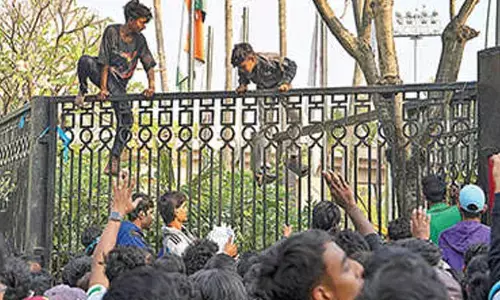Lull in monsoon continues State is experiencing revival of summer

After just two weeks of heavy downpour the South Western monsoons has again started playing hide and seek as a result the inflow into 12 reservoirs in the Western districts has shown downward trend
Bengaluru: After just two weeks of heavy downpour the South Western monsoons has again started playing hide and seek as a result the inflow into 12 reservoirs in the Western districts has shown downward trend, while the inflow into reservoirs in the eastern districts has trickled down to the pre monsoon levels raising the fears of an impending water scarcity for agricultural operations for 2023 Khariff crop throughout the state.
With entire August gone without much rains, the Khariff cultivation has taken a beating and farmers have begun despairing almost all places in the state except the North Cauvery basin. According to the statistics available with the agriculture department only 14 per cent rain fed areas have got adequate rains and the paddy cultivation is somewhat on par with that of the 2022 monsoons. With no outflow or minimal from the reservoirs the farmers are now unsure of a good harvest in October . “Our district is the rice bowl of Karnataka and going by the agriculture calendar our initial operations like ploughing the fields, preparing the nursery and flooding the fields should have been over by Aug 28th but with the rain doing the disappearing act we are yet to begin even the first phase of the Kharif operations said Manje Gowda Mandya taluk farmers association told, Officials in the district agriculture office confirmed that the Khariff operations have not started which was a cause for worry.
This perennially green district was an indicator of the health of agriculture for the entire Southern Karnataka. Inflow into the five rivers Kaveri, Hemavathi, Lokapavani, Shimsha and the Viravaishnavi has not increased in the current monsoon period rendering the Visveshwaraiah canal network empty. District officials said the collective inflow into the reservoirs built across these rivers was showing 70 per cent deficiency when compared to the last year’s statistics, unless the inflow improves in the river basin the canals cannot be fed the officials confirmed. However the officials in the minor irrigation department say that following the weather report and movement of monsoons in the region outflow into the canal network will be ensured which will facilitate the farmers to start initial preparations.
The hills of Madikeri getting scanty and deficit rainfall the water level the life giving Cauvery river inflow into the Krishnaraja Sagar reservoir has posted a depressing picture. The daily inflow into the reservoir has trickled down to just 2004 cusecs on in August first fortnight against 13,486 cusecs same day in benchmark year of 2011, causing worry to the administration. The level of water in the reservoir has slid down to 75 feet this year against 100 feet last year on this day.
According to officials at the KRS gauge centre the levels had slid down to just 49.70 feet in 2004 also due to deficit rainfall over the hills. The KRS has a catchment area of 1,27,000 square kilometers which was one the largest among the Southern rivers. However the outflow has been maintained at a healthy 217 cusecs per day against an inflow of 1994 cusecs. At the height of inflow the KRS gets not less than 17,800 cusecs per day to attain a Full Reservoir Level (FRL) of 124.8 feet sometime in first week of August. But at this level of inflow and outflow the reservoir may not reach its FRL.
“This lull in the water level had also been a feature in June last year, the monsoon had revived in second week of June filling up the deficit from 19.89 Thousand Million Cubic Feet (tmcft) to 32.75 tmcft but this time even if the monsoons revives in the first week of Septmeber hopefully, the reservoir might still not get closer to the FRL, which is a worrying factor” say the officials.
The BWSSB officials when contacted said if the rain continues to play truant and the reservoir at KRS did not fill up it could affect water inflow into the Cauvery first and second stage water supply pipeline to Bangalore.
Even the normal rainfall of 40-50 mm rainfall in the catchment area of the Cauvery basin for the rest of the monsoon period will fill up the reservoir officials say.
However the Western theatre of monsoon has shown some movement. All the 12 reservoirs fed by the West flowing rivers have shown considerable improvement in the inflow despite deficient monsoons in the coastal region.
The Kadra reservoir has reached a level of 29.40 meters against the FRL of 34.50, Kodasalli 65 meters(75.50mts) Supa 515 feet (564 feet), Thattihalla 434.60 (468.38) Bommanahalli 434.60 (438.38) Gerusoppa 48.93 meters(55 meters) and Linganamakki 1747.95feet (1819 feet). Dakshina Kannada does not have any reservoir except the one in Thumbay which serves only for domestic use which is now submerged at 13 feet.
Monsoons defy all predictions
The Monsoons 2023 has belied all predictions, IMD’s predictions has not held water at all in the current monsoons, the first prediction on 12 April predicted normal monsoons with 5 per cent variation ranging from 96-104 per cent up to end of July but now according to the rainfall statistics the present condition was 49 percent deficient rains in South and North Interior Karnataka and 23 per cent deficient in the coastal region.
Secondly even the almanac predictions have proved wrong. The Ashada according to the Hindu calendar was supposed to be full or rains. The rains were supposed to be so intense and heavy. All the daily star signs like Mrigashira, (even the animals will not be able to put their heads out –Mriga=animals, Shira=head) Punarvasu, Pushya and various others signs indicate heavy rains, but this monsoons none of them worked.



















